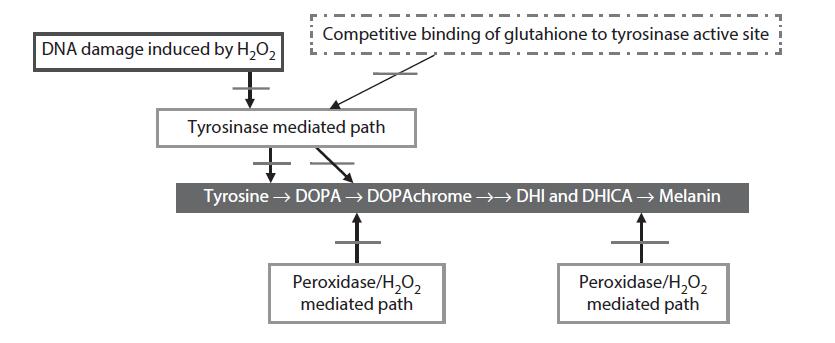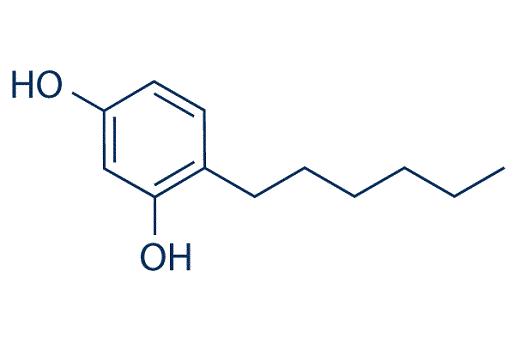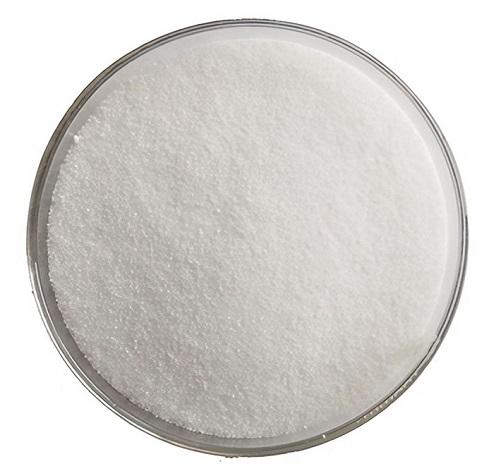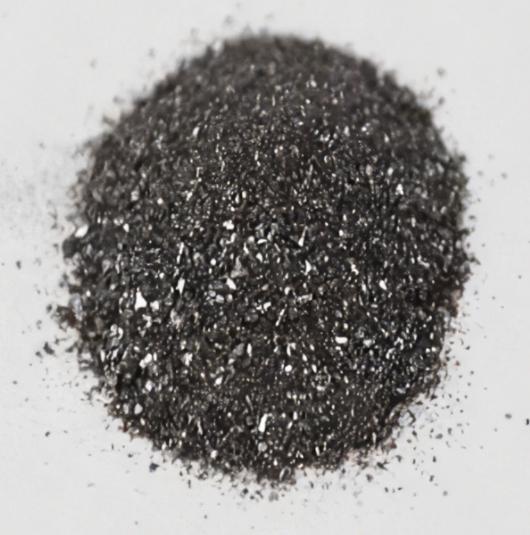Hexylresorcinol: Providing Skin Benefits by Modulating Multiple Molecular Targets
Background
Hexylresorcinol (HR) is an alkylresorcinol (AR), a type of phenolic lipid, having an n-hexyl chain attached to the 4 position of the 1,3-dihydroxybenzene ring (Figure 7.1). It can be synthesized by reacting resorcinol with hexanoyl chloride in the presence of Lewis acid catalyst. The resultant intermediate, hexanoylresorcinol, is then reduced to hexylresorcinol. Subsequent purification of HR is attained by, e.g., crystallization using suitable solvent(s).
Hexylresorcinol is an ingredient that has attained GRAS (Generally Recognized as Safe) status and is effective as an anti-browning agent for prevention of melanosis in shrimp.1 HR has also been shown to be a very effective inhibitor of surface browning on many fresh-cut fruits, such as apples, pears, mangoes, etc.2,3 When combined with ascorbic acid, it has a synergistic effect in the prevention of browning. Here, ascorbic acid reduces quinones generated by polyphenoloxidase while HR specifically interacts with polyphenol oxidase, and renders it incapable of catalyzing the enzymatic reaction.4,5 A post-cutting dip of HR, ascorbic acid, and calcium lactate was found to extend the shelf-life of pear slices from 15 to 30 days.6 Similarly, Red Delicious apple slices treated with an anti-browning dip (HR, isoascorbic acid, N-acetyl cysteine, and calcium propionate) and held at 5°C maintained visual quality for five weeks.7 Although sulfites are more commonly used in controlling browning of foods, HR has several advantages over sulfites, including its specific mode of inhibitory action, effectiveness at low concentrations, inability to bleach preformed pigments, and chemical stability.
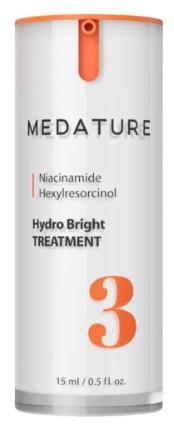
From a human physiological and biological perspective, HR is perhaps one of, if not the most studied and well-known AR. It is reported to have anesthetic, antiseptic, and anthelminitic properties and can be used topically, e.g., on small skin infections or as an ingredient in a consumable carrier, e.g., throat lozenges. As a throat lozenge it manifests both antiseptic and local anesthetic effects: its antiseptic action killing the bacteria that may be associated with a sore throat, while its anesthetic action helps relieve the pain associated therewith. Here, the action of sucking the lozenge allows the active ingredient to work in the area of the discomfort, and also helps to coat, lubricate, and soothe the irritated throat tissue. ARs are also found in nature; alkyl chains C17:0–C25:0 attached to 5 position are abundant in wholegrain wheat and rye. ARs are reported to have antitumor, antibacterial, antifungal, and antiparasitic activities. These effects of ARs were attributed to membrane-modulating effects due to interactions of their alkyl tails with phospholipids and/or proteins and to antioxidant effects of the phenolic hydrogen. HR has a long history of human use. The earliest citation to its use in humans appears to be that of Dr. Veader Leonard and his associates at the Johns Hopkins School of Hygiene and Public Health in Baltimore, Maryland.* As reported, Dr. Leonard and his associates were looking for a “perfect” antiseptic that was deadly to germs but harmless to man. In the course of their efforts, they found that HR possessed over 50 times the germ-killing power of pure carbolic acid.
Despite its long history of use as an antiseptic, anesthetic, and anthelminitic, it is only recently that its
use and benefits as an active ingredient for skin care applications has been realized. In 2007, Sytheon
Ltd. introduced HR as a cosmetic/skin care additive for use as a skin protectant having skin lightening
and even-toning properties under the trade named Synovea® HR. Its utility in this application is
believed, in part, to arise from the ability to attain highly purified HR (>99%, typically ranging from
99.5% to 99.9%) which is essentially free of resorcinol, a known skin irritant, and hexanoylresorcinol,
the intermediate.
Focusing on the human physiological and biological properties of HR, attention will now be given to its antimicrobial, antitumor, anti-aging, and skin lightening/even-toning properties in particular.
Antimicrobial
On July 22, 1991, the U.S. Food and Drug Administration (FDA) published the Tentative Final
Monograph for antimicrobial drug products—first aid antiseptics13—in which HR was identified as a
category I antimicrobial ingredient. HR has been used extensively in antibacterial mouthwash and, as
noted above, throat lozenges. Antibacterial mouthwashes are effective due to the presence of HR, which
inhibits the growth and proliferation of microorganisms found in the mouth: thus preventing caries and
ameliorating infectious conditions. As a side benefit, mouthwashes having HR also prevent or reduce
halitosis, which, in many instances, is generated or arises from various microorganisms in the mouth.
As noted above, lozenges such as Strepsils® Extra Blackcurrant Lozenges containing HR possess both
antiseptic properties to fight bacterial throat infections and anesthetic properties to soothe and numb
throat pain.
The emergence of pathogenic bacterial strains resistant to currently available antimicrobial agents
continues to be a universal problem of ever increasing importance.14 Extensive efforts have been undertaken
to validate new target enzymes for antimicrobials; however, these have met with little success,
with the majority of successful drugs inhibiting just a handful of cellular processes. To date, one of the
most successfully exploited drug targets has been the DNA topoisomerase (topo) class of enzymes. For
example, recent studies by Taylor et al. have shown that HR has good DNA topoisomerase inhibitory
activity (IC50 30 μM), which compares well with m-Amsacrine (30 μM) and Purpurin (40 μM).
Chaudhuri has also demonstrated excellent antimicrobial activities of HR in an, as yet, unpublished
work. Specifically, Chaudhuri conducted an evaluation to assess the minimum inhibitory concentration
values (MIC in μg/mL) of HR against various organisms relevant to personal care applications in
accordance with U.S. Pharmacopeia’s Compendia Products procedure for Category 2 (USP 26-87 pp.
2022–2026). The results are given in Table 7.1.

FIGURE 7.1 Structure of hexylresorcinol (HR).
In addition, Chaudhuri conducted a challenge test using 0.5% (w/w) level of HR in a lotion. The results showed a 3-log reduction of fungi, but not the desired reduction of bacteria. Nevertheless, it appears that HR can act as a synergist in combination with existing commercial antimicrobial ingredients.
Antitumor
HR has also found potential utility as an antitumor agent, particularly in relation to differentiation therapy. The signaling pathways related to cell differentiation and senescence fail to function properly in malignant tumor cells. As a result, tumor cells exhibit uncontrolled and invasive growth. Differentiation therapy is currently being considered as one of the key emerging techniques for the treatment of cancer. 16 Kim et al. have recently shown that HR induces the differentiation of SCC-9 via the modulation of the E2F-mediated signaling pathway and suppressed the growth of SCC-9 cells in a dose-dependent manner.17 In this study, the authors also found that HR increased the expression of the epithelial cell differentiation markers involucrin and keratin 10.
Following on the foregoing, Kim and Choi have further demonstrated that HR dose-dependently induced SCC-9 cell apoptosis as determined by caspase-3 activity, annexin V expression, as well as by scanning and transmission electron microscopy. HR was shown to inhibit intracellular calcium oscillation in both SCC-9 cells and normal human dermal fibroblasts. HR-induced apoptosis was partly reversed by calcium channel blockers. Additionally, HR reduced the tumor mass formed by SSC-9 cell implantation in BALB/cAnNCrj-nu/nu mice and mass size reduction was also partly reversed by the concomitant application of calcium channel blockers. The results of this study suggest that HR is providing strong antitumor effects by inhibiting calcium channel oscillation and inducing apoptosis.
Finally, the resistance to chemotherapy is very important in the prognosis of tumors. Transglutaminase-2 (TG-2) mediated chemotherapy resistance has been widely reported. TG-2 is overexpressed in many cancers such as breast cancer,19 malignant melanoma,20 and glio-blastoma and facilitates tumor spread and metastasis. Recently, Kim et al. reported on their finding of an inhibitory effect on TG-2 enzyme activity by HR.17 Additionally, when the authors compared the performance of a mixture containing 5 μg/mL HR and 5 μg/mL cisplatin (a common chemotherapy drug) to 10 μg/mL of cisplatin alone on tumor cells, they found the application of the mixture resulted in significantly lower tumor cell viability than the cisplatin alone (p < 0.05). Accordingly, it is believed that HR has a synergistic effect on KB cell death when employed in combination with cisplatin. The authors also examined the effects of the combination of cisplatin and HR on oral mucosal melanoma (OMM) using cultured primary OMM cells in a tumor xenograft model. According to their findings, the combination resulted in fewer metastases and longer survival than cisplatin-only treatment in the OMM xenograft model. Based on these findings, it is now believed that HR could be a viable candidate as a chemotherapeutic agent in the treatment of cisplatin resistant tumors.
Anti-Aging
Recent findings also demonstrate the influence or impact of HR on a variety of processes involved in skin aging and damage, including oxidation, inflammation, and glycation.
Antioxidant
Although HR would not typically be expected to be an effective conventional antioxidant (radical and/or non-radical quencher) based on its structure23; it may still be considered an antioxidant in a broader sense because its metabolites, such as, 1,2,3-trihydroxy- and/or 1,3,5-trihydroxy-4-hexylresorcinols, can have potent radical and non-radical quenching activity. Antioxidant activity may also be attributed to HR, though indirectly, as a result of its ability to stimulate the cell protectant glutathione and various antioxidant defense enzymes such as glutathione peroxidase and glutathione reductase. For example, Yen et al. have demonstrated that HR has a protective effect against oxidative DNA damage in human lymphocytes induced by hydrogen peroxide.
Inflammation
Inflammation is a complex physiological process and the role of transcription factor NF-kappaB in the inflammatory response has been well documented. NF-kappaB is activated by numerous stimuli and once fully activated participates in the regulation of various target genes in different cells to exert its biological functions. NF-kappaB has often been referred to as a central mediator of the immune response since a large variety of bacteria and viruses can lead to the activation of NF-kappaB, which in turn controls the expression of many inflammatory cytokines, chemokines, immune receptors, and cell surface adhesion molecules.
Recently, Kim et al. reported that HR inhibited NF-kappaB phosphorylation. Independently, Johnson & Johnson scientists found that HR has a stimulating effect on collagen and elastin synthesis through NF-kappaB inhibition. Based on these findings, and the fact that inflammation has a significant effect on skin aging, it is anticipated that HR would provide an anti-inflammatory as well as anti-aging effect on skin when applied topically.
Glycation
Glycation is the term used for a class of non-enzymatic reactions that occurs between sugars, such as glucose or ribose, and proteins and lipids, including, e.g., the reaction between the nucleophilic amino group of proteins and a reducing sugar wherein the sugar becomes bonded to the protein. Glycation is the first of a series of reactions by which advanced glycation end-products (AGEs) are formed: the subsequent reactions include Schiff base reactions, Amadori reactions, and Maillard reactions. Though not all glycation reactions lead to AGEs, physiological and biological conditions will shift the reactions to favor or disfavor their formation.
AGEs are heterogeneous compounds which adversely affect nearly every type of cell and molecule in the body and lead to human pathological conditions. AGEs are thought to be one of the key factors in skin aging. For example, studies of collagen glycation using skin equivalents29 found a number of changes including modified fibroblast shape and distribution, enhanced extracellular matrix molecules and the dermal-epidermal junction zone, and increased collagenase activity. Additionally, AGE treatment has been found to reduce various biomarkers of skin aging, including those noted above, as well as increased NF-κB activation and cytokine expression. Exposure of AGEs to ultraviolet (UV) light generates reactive oxygen species (ROS) in extracellular matrix.
Turning to HR, it has been reported to have an inhibitory effect on the formation of Maillard reaction products (in vitro using glucose and cysteine). Given the importance of Maillard reactions in the formation of AGEs, it is expected that HR, when applied topically, would provide skin benefits due to its anti-glycation/anti-AGE property.
You may like
Related articles And Qustion
Lastest Price from 4-Hexylresorcinol manufacturers
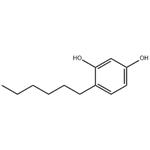
US $0.00-0.00/kg2025-09-08
- CAS:
- 136-77-6
- Min. Order:
- 1kg
- Purity:
- 98%
- Supply Ability:
- 1
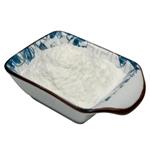
US $1000.00-700.00/ton2025-04-21
- CAS:
- 136-77-6
- Min. Order:
- 1ton
- Purity:
- 99%
- Supply Ability:
- 5000

